Our blog has moved to:
www.wordpress.interdrythailand.com
Of course you are free to browse this blog and leave your comments.

Our blog has moved to:
www.wordpress.interdrythailand.com
Of course you are free to browse this blog and leave your comments.
1. How does Nordic Power Desiccants help solve moisture problems?
This unique product absorbs moisture by extracting water vapor present in the air, thus preventing the humidity inside the container from reaching dew point and condensing. The desiccant then starts to turn into a gel as it continues to absorb moisture. The water absorbed is retained due to the presence of a special binding agent, thus preventing it from leaking. Lower relative humidity Nordic controls the humidity inside containers by preventing the air from reaching dew point and condensing, thus protecting your precious cargo.
2. What is Relative Humidity (RH)?
Relative humidity measures the amount of moisture in the air. It is expressed in a percentage of how much moisture the air could possibly hold. The wetter or damper the air is, the higher the relative humidity. The drier the air feels, the lower the relative humidity. Thus, 100% humidity is actually rain.
3. What are the most common problems caused by moisture?
Moisture in containers causes problems such as mold, fungus, mildew, rust decay, lumping, caking, agglomeration, and decomposition. Moisture can also cause electronics to malfunction.
4. Is moisture damage always instantly visible when handling the cargo?
Unfortunately not. Though common forms of moisture problems such as corrosion, mold, or fungus are visible on the cartons, surfaces etc there are some kinds of damage that is not visible.
Mostly these damages are internal and visible only when the customer opens the shipments. In the case of devices, they often cease to function the way they should.
5. I fumigate my containers; do I still need to put in desiccants?
Fumigation and using desiccants have two different purposes and are not alternatives to protect your goods against moisture damage. Fumigation is primarily to eliminate insects and eggs in the container and in the goods. It has no influence on the humidity inside a container. Desiccants will not influence the effects of fumigation and can easily be put in before or after fumigation.
6. If I use Nordic, will I have any more moisture problems?
Nordic Prevents Moisture damage by controlling the Relative humidity and indeed prevents those problems. However, the ventilation holes in the container need to be closed and the number of units to be put in a container needs to be adjusted to the situation.
7. I load my container under dry conditions and it is very tightly sealed. How come I still experience moisture problems?
If there are still moisture problems, we can easily say that the number of units per containers currently is not sufficient and it is advisable to increase the units per container. There are many factors for bigger amounts of moisture inside the container.
Examples of those factors are:
Container Floor: Recent studies carried out by R&D department, proved that the moisture content of the wooden floors is higher than they used to be. That is partly because of the quality of the wood that is being used nowadays and partly because the floors are being cleaned with water and they are not dried out enough before being used.
See also our post: https://interdry.wordpress.com/2010/10/10/does-a-container-floor-have-any-effect-on-the-relative-humidity-in-a-shipping-container/
Packaging: Wooden pallets always contain more than 20 % moisture, which always causes problems whichever products are put on the pallets. The packaging, often being cartons, contains a lot of moisture in itself, which will spread into the cargo or vaporizes into the air.
Products: The biggest factor of moisture inside a container is the products itself. The MC varies roughly spoken between 10% and 35%. When the MC reach the 25%, the cargo is in the danger zone.
Journey and climate factors: When all the above mentioned factors are controlled and there is still a problem, they surely are the conditions during transport. The first point of consideration is the transport time. It depends on the destination and more importantly the climate during shipment and final destination.
Basically, the changes in temperature and automatically the relative humidity is the cause of condensation. If long transits cannot be avoided, again our advice is to add more units to absorb the extra water molecules.
See also our post: https://interdry.wordpress.com/2012/01/27/ocean-container-temperature-and-humidity-study-2/
8. I ship consumer goods in tubes/cans/jars etc that contain no moisture, yet I still have problems.
As said before the moisture comes from the container floor, pallets, open ventilations, weather change during journey. And it will condense on the tubes/cans/jars that cause corrosion and labels to fall off.
9. Each container of my cargo of peanuts/coffee/cocoa contains tons of moisture. What difference does it make if Nordic absorbs a few liters moisture during a voyage?
Nordic absorbs the exceeding water molecules in the air and reduces the Relative Humidity inside the container, so that it will not reach the dew point.
10. Does it make a lot of difference that my cocoa beans have a moisture content of 8% instead of 7%?
One percent more or less doesn’t make a difference, especially not when the MC is on the lower side.
11. My cargo of peanuts had suffered damage in the centre even though the outside of the cargo looked fine and there were no signs of condensation. Why?
Condensation on the surface of your cargos can evaporate quickly, but it takes more time for the moisture which gets
trapped deeper. Before it evaporates back to the air, mold and fungus would have already grown.
12. How does Silica gel works?
Silica gel is the most common type of desiccant in use today. It is porous sand and can absorb moisture in the air. However, silica gel absorbs moisture best in small, confined spaces and often ends up getting saturated in a very short time span, making them unsuitable for container shipments. Beware that some silica gel – the blue contains cobalt – is toxic, and cannot be disposed of any which way.
13. Do I still need to use silica gel in my boxes?
It is definitely not a bad idea to use sachets of silica where the air is tight, and moisture is trapped, like in boxes and items packed in plastics.
14. My Cargo was damaged even though I used a lot of silica gel and there was no condensation. Would it help to switch to Nordic?
Perhaps there was not enough Silica Gel put inside the container. You need about 40Kg Silica Gel for a 20″ container. I can assure you a better result with Nordic Power Desiccants. Silica works pretty well in smaller closed spaces, like shoeboxes. It absorbs very quickly and is often already saturated before the container is moved.
15. What is so great about Nordic anyway?
We have superb products that actually reduce the RH inside the container. When it absorbs moisture, the powder base will change into a gel. It is more efficient and safe in use. Even when the product gets damaged, it will not spill any water on the goods. It is easy, safe, and inexpensive solution for the problems with moisture damage.
16. How many units must be put in one container?
That depends on many things. The container size, the cargo, moisture of cargo, moisture of container’s floor, moisture of pallets, length of journey, and weather during journey and so on.
An example: a 20 feet container with KD (Kiln Dried) furniture needs 4 units, while 20″ air dried furniture needs 6 units. We generally offer expert advice regarding optimum usage of the desiccants for best results.
17. Do I need to line my container with Kraft paper?
Sweat or Kraft paper is a commonly used method of containing “rainfall” that occurs inside a container. Normally it is installed under the ceiling to absorb the moisture that may occur due to container rain. It is most useful while shipping goods that have very high moisture condensation, but it cannot replace a desiccant that soaks up the humidity before it even turns into rain.
18. My containers are stuffed till the top. Can Nordic still be useful?
It seems that there is almost no free air in the container, while there is actually a lot of free air between the products, and Nordic absorbs the moisture in that air and prevents condensation.
19. I have problems with mold growth inside my shrink-wrapped pallets. Will Nordic help?
No, unless you make holes so the water molecules won’t get trapped.
20. My shipment of steel/galvanized components, aluminum, machinery etc. arrives corroded, stained or discolored, despite heavy packaging. Will Nordic help?
Yes, as long as you put enough units per containers and do not wrap the items in plastic.
21. Can I re-use my Nordic Power Desiccants?
Nordic Power Desiccants are one-time usable, environmental neutral and disposable as normal waste.
22. My cargoes are outdoor furniture with brass parts on it. When the goods arrive at the destination, the wooden part is in perfect condition but the brass part has slight stains on it. What should I do to avoid this? Should I use more units of Nordic?
In some cases, it can happen. I can suggest adding one or two more units and wrapping it properly with only single face carton.
23. I notice that two kinds of containers available in the market right now, which are steel and aluminum types. If I shipped the same commodity inside of steel and aluminum containers should I used same numbers of Nordic or not?
There is not much difference between those containers, so you don’t have to adjust the number of units.
Related articles:
By: Pakarada Premtitikul
General Manager
InterDry (Thailand) Co., Ltd.
Let’s have a look at three commonly used shipping routes and what this does to the temperature and humidity inside the shipping container.
We’ve chosen three routes, namely Japan – Netherlands, Japan – Memphis and Japan – Portland.
A normal shipment consists of three distinct stages. The first stage includes the time from container filling until the container is loaded onto a ship. This includes road transportation and brief periods of storage. Daily cycles of temperature and humidity are common. For example, figure 2 includes temperature swings of 40° F [22°C] during the first stage of a shipment from Japan to The Netherlands.
The second stage is the actual time at sea or aboard a ship. This may or may not be the longest stage during the container’s journey. During this stage, daily cycles of temperature and humidity are usually very minor or completely non-existent. Temperature changes are gradual, often occurring over days rather than hours. Occasionally, a single temperature/ humidity cycle occurs as the ship makes stops along the route, however extreme conditions are rare. Figure 3 includes a slow temperature rise and fall as a winter route takes the ship near the equator and then north to The Netherlands.
The final stage begins when the container is removed from the ship and continues until the recorder is removed during the freight unloading process. This may include varying periods of time spent in customs, on trains, on trucks, and in storage. Daily temperature and humidity cycles are common and may be extreme.
Typical summer shipment – Japan to the Netherlands
Typical winter shipment – Japan to the Netherlands
Some of the most interesting recordings are the extreme conditions. The highest recorded temperature occurred on July 25, 2005 during a shipment from Japan to Memphis. The temperature reached 135° F [57° C] during the third stage of this shipment (figure 7).
Hottest shipment 135°F (57°C) – Japan to Memphis (USA).
Coldest shipment -21°F (-29° C) – Japan to Memphis (USA).
The lowest recorded temperature occurred on January 15, 2005 also along the Japan to Memphis route (figure 8). The temperature dropped to -21° F [-29° C], which is slightly beyond the recorder’s published temperature range.
The shipment with the highest relative humidity occurred during a trip from Japan to Portland. The relative humidity was recorded at 96% on August 5, 2005 while the container was on land. Figure 6 shows the detailed temperature and humidity profile. The most extreme humidity conditions are seen during periods of large daily temperature changes. In this example, as the temperature slowly drops from 88° F [31° C] to 67° F [19° C] over 9 days, the humidity increases to 88% before returning to 79%. However, starting on August 4 as the temperature dropped from 121° F [49° C] to 68° F [20° C] over a 16 hour period, the relative humidity rose from 32% to 96%. The corrugated boxes seem to absorb moisture fast enough to temper humidity during slow changes in temperature while at sea. However, rapid temperature changes seen on land seem to exceed the rate at which the corrugated boxes can absorb moisture.
Highest relative humidity 96% – Japan to Portland (USA).
Be sure to check out the following page for more information on how desiccants can save your valuable cargo:
By: Pakarada Premtitikul
General Manager
InterDry (Thailand) Co., Ltd.
In this experiment, a piece of plywood, used for container flooring at MSC, was conditioned at 23 ° C and 50% relative humidity. The piece of wood was placed in a climate test cabinet at 45 ° C and 75% RH where the wood absorbs moisture. Every day the wood was weighed and the moisture content of the wood was determined. With this procedure we have more knowledge about the speed at which wood reaches its hygroscopic balance.
The wood was protected with tape in places where in reality it is not subjected to the internal container air. Following pictures show how the wood was protected.
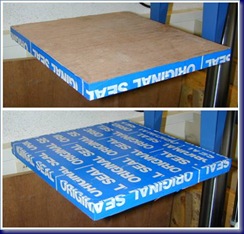
The tested piece of wood top and bottom.
The initial mass of the wood was 3259g. Following graphs show the results of the test. The first chart shows the mass of absorbed moisture per day. The second chart shows the increase in the moisture content of wood per day.
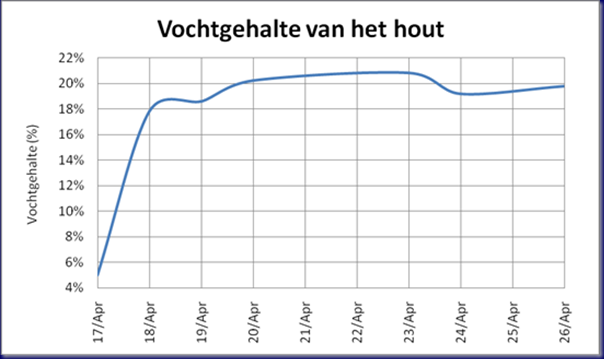
Increase in the moisture content of wood
Unfortunately, the hygroscopic equilibrium had not been reached before the trial was stopped. The moisture content remained almost constant after 3 days. Yet the wood continued absorbing moisture. Since it is plywood, that means that once the moisture content of the top layer remains constant, the moisture will move to the lower layers of wood.
In order to see the difference between climate change and the change in the moisture content of the container floor in a container with a desiccant and a container without desiccant, the following experiment was made.
Two containers at MSC were used for this test. One container (container U6472633 MSC) was provided with desiccant and the other container (U1089745 MSC) was left as it was. The ventilation holes in the two containers were sealed with tape.
A data logger was used in both containers to measure the changing climatic conditions. In container U6472633 MSC a probe was placed near the ceiling and a probe on the floor. In container U1089745 MSC a probe was mounted on the ceiling and a probe on the outside of the door to measure the outdoor conditions. Following figure shows the positions of the probes of logger 56,844 in container MSC U6472633 and logger 56,845 in container U1089745.
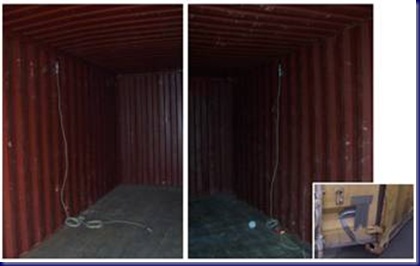
Before the container doors were closed, the moisture content of the floors were measured. Following figure shows the moisture content of the container floor at various locations in the two containers before the start of the trial.
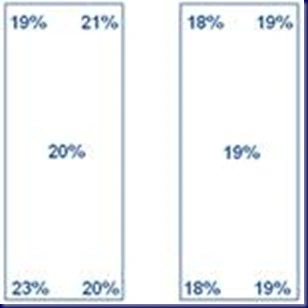
The test was performed over a period of 28 days at the port of Antwerp, and below are the results of the data loggers.
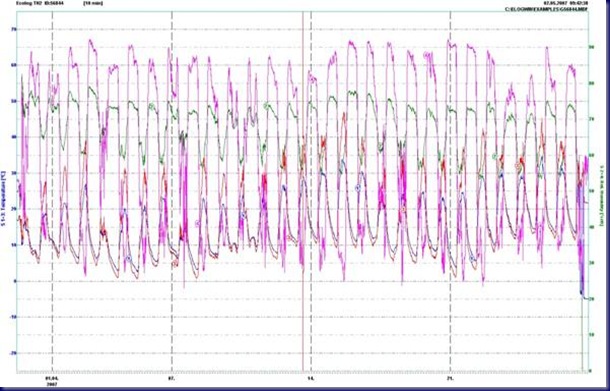
The purple curve and the green curve are respectively the relative humidity near the ceiling and the relative humidity near the container floor.
It can clearly be seen that fluctuations in relative humidity in the vicinity of the ceiling are much higher than those in the vicinity of the floor.
The purple curve shows maxima of 85% and 90% and minima of 30% and 40%. The green curve shows maxima of 70% and 75% and minima of 55% and 60%.
The blue curve and red curve are respectively the temperature near the ceiling and the temperature near the floor.
The fluctuations near the ceiling were slightly larger than those near the floor. The minima of both are roughly equal at about 10° C. The maximum temperature at the ceiling was about 40 ° C and at the floor approximately 30° C.
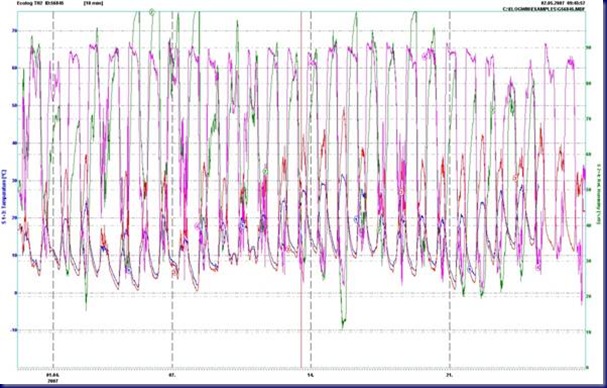
The purple curve and the green curve are respectively the relative humidity near the ceiling and the relative humidity outside the container.
The fluctuations of relative humidity are not comparable because outside the container it was sometimes larger and sometimes smaller.
The blue curve and red curve are respectively the temperature near the ceiling and the temperature outside the container. Minima are comparable, but the maxima showed extreme differences. The maximum temperature at the ceiling was about 40 ° C and outside about 30 ° C.
For a better comparison between the climate of both containers, the temperature changes and changes in the relative humidity near the ceiling are shown in the figure below.
The temperatures were almost exactly the same. The relative humidity, however, showed some differences. The relative humidity in the container with the desiccant showed smaller maxima.
The explanation lies in the fact that an amount of moisture was absorbed by the desiccant resulting in less moisture in the air, resulting in a lower relative humidity.
After weighing the desiccant, it was discovered that a total of 4.465 kg of moisture was absorbed. Since the air in a container itself contains little moisture, this must have been moisture from the floor. The desiccant always causes a lower relative humidity in the air so the floor was looking for a new hygroscopic equilibrium. Therefore, the moisture of the floor in the container with desiccant should have dropped as well. Next figure shows that this indeed is correct.

The moisture content of the container floor in MSC U6472633 decreased 2 to 5%, while the moisture content in container MSC U1089745 remained constant.
There are so many variables to be taken into consideration that it is practically impossible to determine a precise figure on the number of desiccant needed within a container.
Nevertheless, significant conclusions can be made such as the fact that a container floor is one of the main sources of humidity.
Desiccant always absorb more at higher temperatures and higher relative humidity. High relative humidity provides a high absorption capacity, while a high temperature results in faster moisture absorption.
If the packing unit increases in mass, the rate of absorption decreases, but the active absorption time increases.
When comparing the different desiccant products two main groups are distinguished by their absorption properties, namely the rapid absorbers and those with a long effective absorption time. If a rapid moisture-absorption is desired, for example for a shorter sea voyage, the first group of desiccants holds perhaps the greatest advantage. If a constant fluid intake is desired, the second group is the most desirable.
As the products that continue to absorb also the ones that absorb the most, fewer units are needed for this type of desiccant which is a big advantage. It should be noted that the desiccants with faster absorption, are the clay based desiccants. The desiccants that ultimately absorb the most are the desiccant based on salt.
From the test at MSC can be concluded that desiccants work. Products succeed in absorbing the moisture from the wood to bring down the relative humidity in the air. Because the relative humidity is lower, a new hygroscopic equilibrium needs to be created. In the MSC container was that new hygroscopic equilibrium was created by the wooden floor expelling moisture.
Finally, it should be noted that the choice of desiccant is not easy, but it is determined by a diverse range of interacting conditions such as type of cargo to be shipped, the length of the voyage, the sea route, the season the container is transported and so on.
Related articles

By: Pakarada Premtitikul
General Manager
InterDry (Thailand) Co., Ltd.
During the day the container walls and ceiling heat up. In the evening they cool off leads to accumulation of condensation in the container.
During heating of the container walls and the internal air, the relative humidity drops. The container floor and the cargo will now dissipate condensation by which the absolute humidity in the air rises.
The water from the cargo comes from the upper layers of the load. This reduces the vapour pressure of the liquid inside the cargo which then migrates from the underlying layers of the cargo to the outer layers.
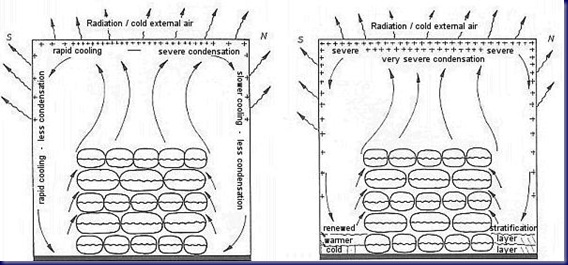
Figure 1: Warming of a container through radiation. The left figure depicts the start of condensation. The right figure, the condensation builds up for the coming days.
If the container warming has reached its peak, the temperature will drop with the result that the relative humidity increases. Part of the moisture will condense on the cooler container walls when their temperature gets below the dew point of the internal air. During the heating that occurs over the following days, the condensation of the vertical walls evaporate into the air so that the cargo needs to evaporate less condensation to achieve balance.
The condensation on the ceiling does not get into thermal contact with the circulating air, but will diffuse to lower drier air. This process is slower than the evaporation of condensation on the vertical walls by dry air. The condensation on the ceiling does not dry despite the heat. So day after day there is more and more because of moisture condensation from the cargo goods.
When the limit is reached, the condensation begins to drip. The right drawing in Figure 1 shows that the majority of the condensation is formed on the ceiling . This is important because condensation on the vertical walls do not directly cause damage but condensation from the ceiling drips into the goods.
The figure below shows the forming of condensation inside a container that was heated during the day. The moment the temperature of the container wall goes below the dew point of air inside the container, condensation forms in the container.
Figure 2: The daily temperature variations in a container: The temperature, relative humidity and the dew point of air, the temperature of the cargo and the container walls.

By: Pakarada Premtitikul
General Manager
InterDry (Thailand) Co., Ltd.
Steel is currently the most used in the construction of containers despite its poor insulation properties. This is because it is cheap in production and maintenance. Another factor is that it is very suitable to absorb the mechanical forces acting on a container. The colour of the paint on the exterior of the container has an impact on the internal container temperature during sunlight. For a better picture of the impact on the container I will show you two colour charts reflecting the temperature changes in a white and a brown container during the course of one day.
The chart below shows the temperature in different places within a white container and outside each hour of the day. The temperature varies between 40 ° C near the roof and 28 ° C near the floor with an outside temperature of about 28 ° C at noon. During the night, the temperature of the air in the container is about 12 ° C at an outside temperature of 15 ° C.
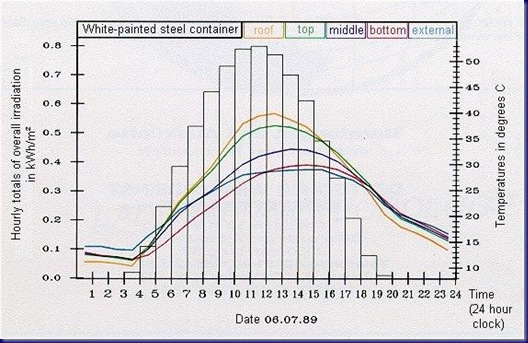
Figure 1: The temperature at different places in a white container at every hour of the day.
A similar study was done with a container with a brown color. There were much higher temperature differences measured. A measurement at midday found a temperature of about 50 ° C near the roof and 35 ° C near the container floor with an outside temperature of 25 ° C.
During the night the air inside and outside the container had similar temperatures, fluctuating around 15 ° C. These measurements are in the chart below
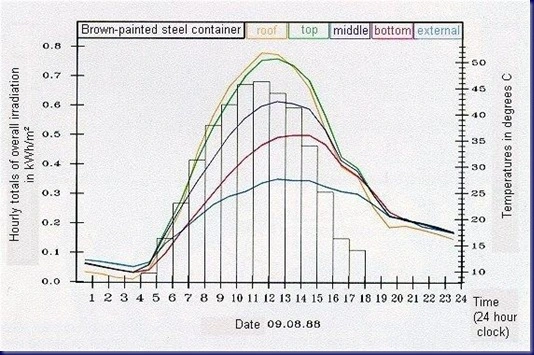
Figure 2: The temperature at different places in a brown container at every hour of the day.
The colour of a container indeed affects the internal temperature. Previous charts showed that a dark container has a temperature increase of about 10 ° C more with the same outdoor temperature (27 to 28 ° C). The relative humidity can change from 80% for example to about 50% which can cause a great hygroscopic imbalance. It also comes with a larger cooling. All the humidity extracted from the goods into the container internal air to balance the hygroscopic imbalance due to the temperature rise in the afternoon will condensate during the drastic drop in temperature in the evening.
The figure below shows an estimate of the occurrence of certain container colour. This estimate resulted from the assumption that the size of the container capacity of 10 major container liners is approximately equivalent to the size of the total number of containers that are transported. And that the container liners only transport using their own containers. Even though bright colours like white, gray and yellow are popular, darker colours like dark blue and even green are also relatively common.
Figure 3: Percentage of container colour occurrence.

Excess humidity at home can cause the appearance of mould, mildew, fungus and all kinds of nastiness that endangers your and your family’s health.
In order to solve the humidity problems in a room, bathroom, store room, etc. first of all you need to find out the cause of the excess humidity:
If the humidity comes from outside, caused by a leak or by defective insulation, our products will help to reduce the level of ambient humidity, but will not solve the problem for good. The best thing to do is to consult an insulation specialist so as to solve the root of the problem.
If the problem is due to excess ambient humidity in the room because of poor ventilation or condensation, our product can solve your problems.
Put the product anywhere in the room and leave it to work. The desiccant will activate automatically, absorbing the excess humidity. Once the desiccant has stopped absorbing, put in a refill. How long the product lasts depends on the temperature and level of humidity in the room.
Nordic Power Desiccant regulates the level of ambient humidity to bring it down to the recommended optimum level of 45-50%, without drying out the atmosphere, absorbing only the excess humidity.
All Nordic products are non-toxic. They can be used without any problem in any room in the house, whether inside a wardrobe, in bathrooms or in store rooms – even in bedrooms. They are also very popular for use on a boat or yacht.
The desiccant contained in the product is calcium chloride, hygroscopic salts which are non-toxic and environmentally friendly.
From: http://www.doityourself.com/stry/finding-and-identifying-basement-mold
Basement mould is a term refers to the types of fungus that grow in basements under certain conditions. Basement mould is harmless in small quantities, but as it grow, it becomes more and more of a health hazard. Some will cause certain types of allergic reactions while others are outright poisonous. If left untreated, the basement mould will keep growing, eventually spreading through the entire building. This is why you must find the mold before the problem gets out of hand. Once you find it, you will need to be able to identify it—otherwise, you won’t be able to figure out how to get rid of it.
One of the easiest ways to identify the mould is by it’s stench. However, this is only true for some types of basement mould, others may not start to smell until their growth reaches a certain stage. That is why you may want to take a more proactive approach and check the spots where the mould is most likely to emerge. That way, you will have a better chance of spotting it while it is still at manageable size.
Basement mould needs a wet environment in order to grow. It will grow near the pipes and along the walls. The mould feeds on common household materials such as plywood, drywall, furring strips and carpet padding, as well as dust and cellulose in carpets themselves. Try to check any parts of the basement that are hospitable to mould at least once every week. Be sure to bring a flashlight with you—you may not be able to get adequate illumination without it.
If your basement suffers any sort of flooding, the walls will become infested with mould spores, which will remain dormant until they come in contact with water. The spores can remain dormant for a long time. Just because the mould didn’t develop after the flood doesn’t mean it won’t become an issue several years down the line.
If you find a patch of mould, try not to inhale too deeply and don’t touch the mould with any part of your body. If it gets on your clothing or your tools, wash it immediately. You can identify the mould by sight, so there is no reason why you should be touching the mould in the first place.
Basement mould can be identified based on a number of factors. First, there is colour. Basement mould comes in a variety of colours that range from light gray to black. They may have green, blue and/or brown tinges. If the mould is closer to black, it is either the Stachybotrys or Cladosporium molds. If it’s closer to light grey, it is either Aspergillus or Fusarium moulds.
To figure out which type of dark mould and you have, look at the texture. If the basement mould looks slimy, it is probably Strachybotrys. Otherwise, it’s Cladosporium.
To figure out what kind of light coloured mould you have, look at the growth pattern. If the mold grows in disjoint circular patches, it is most likely to be Aspergillus. Otherwise, it’s Fusarium.
If possible, try to get the mould tested in a lab. While the factors described above are usually fairly good indicators, only the professional analysis will be able to tell for sure. If the mold patches are small, you may be able to remove it yourself. However, if the patches are fairly large, you will need professional help.
From: http://www.doityourself.com/stry/finding-and-identifying-basement-mold

Q: How do Nordic absorbers help to solve moisture problems?
Nordic absorbers contain Calcium chloride that very aggressively grab and absorb moisture from the air. They dry the air. When the air is dry, there are no moisture problems.
Q: Can Nordic absorbers solve all moisture problems?
Well, not all. Some cargoes may be so wet that any reasonable number of Nordic absorbers get overwhelmed. But Nordic absorbers can reliable protect even very difficult cargoes that may contain tons of moisture, such as coffee beans, wood products or paper.
Q: I load my container under dry conditions and it is very tightly sealed. How come I still experience moisture problems?
Your cargo or the packaging, including container floors, pallets and crates, contain moisture that is evaporated into the air during transport. Wet packaging material is the most common cause of unexpected moisture problems.
Q: I have shipped the same cargo for years with Nordic absorbers without any trouble, but now I have a lot of damage. Have you changed the poles?
Check your container and your packaging material. Did you just start to store your pallets outdoors? Does your forklift drive into the container with snow on the wheels? Did you just change supplier of crates? You can’t tell by looking whether wood are carton is dry. The moisture properties of wood and cartons have an exponential character. It makes a huge difference if your pallets moisture content should be 20% instead of 17%, say.
Q: I ship consumer goods in tubes/cans/jars etc that contain no moisture, yet I still have problems.
Consumer goods are often shipped with a lot of cardboard packaging. Even if the boxes seem dry they could literally hold tons of water.
Q: Each container of my cargo of peanuts/coffee/cocoa contains tons of moisture. What difference does it make that Nordic absorbers absorb a few litres during a voyage?
All the important things that happen have an exponential character. That means that a small change in circumstances can have a huge effect on the outcome. Nordic absorbers create circumstances that allow almost all of the moisture to remain in the cargo even while the level of humidity in the air is lowered by a crucial amount, sufficient to prevent damage. It is a question of ”leverage”.
Q: Does it make a lot of difference that my cocoa beans have a moisture content of 8% instead of 7%?
Yes, such a difference could be all the difference between no damage and disaster. The moisture behaviour of most agricultural products have a strong exponential character.
Q: My cargo of peanuts had suffered damage in the centre even though the outside of the cargo looked fine and there was were no signs of condensation?
Lots, if not most, damage to cargoes is caused by prolonged periods of elevated humidity without any condensation (Container rain, Container sweat, Super Saturation Event). It is common that cargoes loaded at cool temperature and then moved into warm condition suffer damage in the centre of the cargo as a result of a difference in temperature between the outside and the centre of the cargo. Warm air from the outside of the cargo becomes humid as it moves into the cooler centre. Nordic absorbers protect against this effect even though the absorbers are mounted on the container walls.
Q: I had damage to my cargo even though I used lots of silica gel and there was no condensation. Would it help to switch to Nordic absorbers?
Calcium chloride absorbs moisture even when the humidity is not very high. This protects the cargo against damage caused by prolonged periods of elevated humidity. Some kinds of steel start to corrode at 70% relative humidity, moulds can grow at 80% relative humidity and at near 90% relative humidity lots of things go wrong. Yet, Nordic absorbers are also at their most efficient protecting against condensation. Most other products, such as silica gels, are really effective only in very humid conditions and in protecting the cargo against condensation damage.
Q: What is so great about Nordic absorbers anyway?
Well, they will not fall off the wall, get punctured during loading and unloading, leave a wet puddle on the cargo or run out after half the voyage. They are installed in seconds without ladders and take up no cargo space. The capacity of each absorber is big, so fewer is required. The cost of an installation is very competitive, even against much inferior alternatives.
Q: How many absorbers do I need?
The number of Nordic absorbers required to protect the cargo depends on the cargo, the temperature conditions during the voyage, the length of the voyage – and just how safe you want to be. For some really dry cargoes e.g.. steel coils or household removals, 2-3 Nordic absorbers are enough. For a lot of ”normal” goods 4-6 Nordic absorbers is about right. Some cargoes with very difficult moisture properties on long voyages may require up to 16 Nordic absorbers.
Q: Do I need to line my container with kraft paper?
Lots of containers are lined with Kraft paper primarily for reasons of hygiene or to simply isolate the cargo from direct contact with the container walls. The liner will act as a kind of sponge, catching and absorbing any droplets of water and then re-evaporating the moisture into the air. If liner is used without Nordic absorbers it could contribute top a kind of pumping effect, drawing moisture out of the cargo. When used together with Nordic absorbers the liner will act as a buffer in extreme conditions, and will prevent any container rain from reaching the cargo. Much the same can be said for so called dew cloths.
Q: My container is absolutely filled with cargo. Will the Nordic absorbers still work?
Moisture diffuses very effectively, even through a seemingly compact cargo. Experience shows that Nordic absorbers will make a difference even to mould growth inside cartons in the cargo. It is, however, necessary that some free space is left in front of each Nordic absorbers. If some Nordic absorbers have collected less water than others inside a container, there may be a problem with air access to those absorbers.
Q: I have problems with mould growth inside my shrink-wrapped pallets. Will Nordic absorbers help?
Yes, so long that there is some access of air through the top and bottom of the pallets. If this is not possible, a spiked roller may be used to tear holes in the shrink wrap.
Q: My shipments of steel/galvanised components/aluminium/machinery etc arrives corroded, stained or discoloured despite heavy packaging. Will Nordic absorbers help?
You can forget about your Tectyl, coatings, oil-paper and plastic wraps that are expensive both to apply and remove. Your container can probably be equipped with a sufficient number of Nordic absorbers to protect against any damage at less cost than your present packaging.
Q: I got some brine on my hands while removing used Nordic absorbers . Is it dangerous?
No it isn’t. Calcium chloride is non-toxic and environmentally safe. It is the second biggest constituent of sea-salt and is liberally sprinkled over icy roads in cold countries. The brine is somewhat similar to very salty seawater, and may cause irritation and rashes if left to dry on the skin. We recommend that you wear gloves and goggles when handling used absorbers, but should you get splashed by brine just wash off immediately with lots of fresh water.
Q: Can I re-cycle my used absorbers?
The absorbers can not be re-used but can be disposed of environmentally friendly. It doesn’t contain any harmful chemicals.
More information on desiccant and moisture
Calcium chloride based container desiccant to prevent moisture problems
